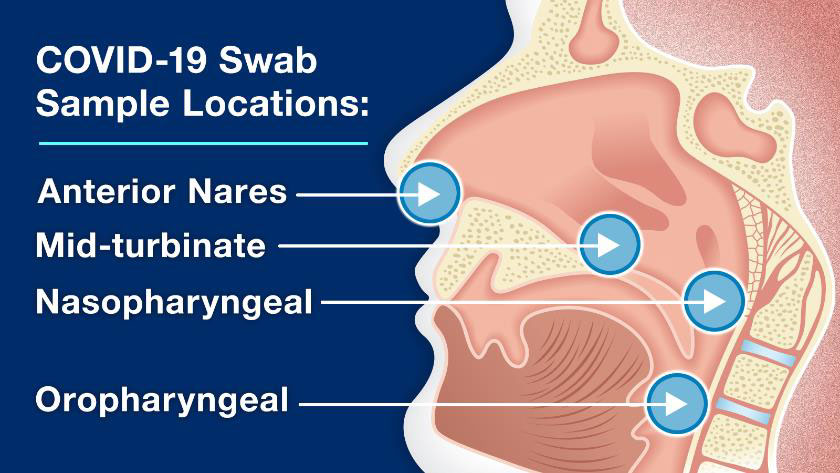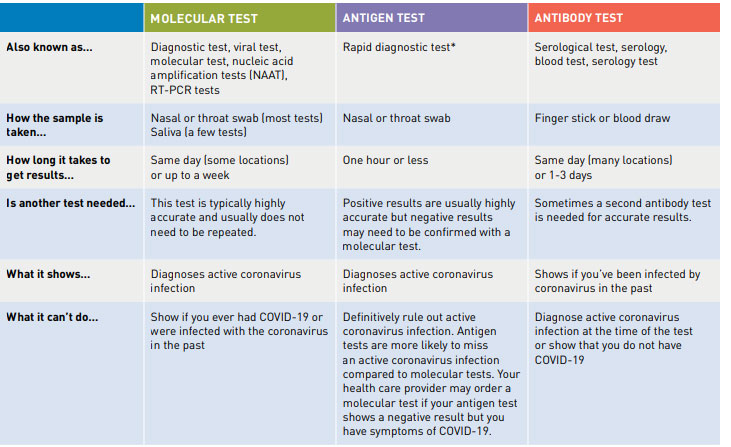Joseph R. Anticaglia MD
Medical Advisory Board
COVID-19 and its variants continue to dominate the news media and the front burners of medical researchers. There is confusion about COVID tests among the general population and there are differences of opinions among medical experts causing head-scratching — ‘What’s going on?’
Testing Basics
1) What are the different types of COVID-19 tests?
Currently, there are two types of COVID-19 tests: the first, diagnostic tests (antigen and molecular tests); the second, antibody tests. Diagnostic tests determine if you have an active coronavirus infection, and whether you should isolate or quarantine yourself. Antibody tests, identify COVID-19 antibodies in the person’s blood (see below).
2) How are people tested for COVID-19?
Diagnostic tests use a COVID-19 swabs (like a long Q-Tip) to collect a sample from the nose or throat. Antibody tests require a blood sample which is sent to the laboratory for evaluation.

3) Diagnostic Tests
A) Antigen tests look for bits of COVID proteins (called antigens) on the surface of the virus. These rapid tests typically use a swab to obtain a sample from your nose, and you get the results in 15 to 30 minutes. They’re fast and inexpensive.
It’s best to use the rapid test within a few days from the start of your symptoms because that’s the time when there is the greatest amount of COVID present in your body.
The accuracy of antigen tests has been called into question. But if you complained of shortness of breath, loss of taste and smell, or flu-like symptoms and tested negative forCOVID-19, it’s prudent to get a molecular test for confirmation.
B) Molecular (PCR) Tests
Molecular tests are the “Gold Standard” for evaluating people who may have become infected with SARS-CoV-2, the virus that causes COVID-19. The nasal swab obtained from the person is placed in a tube and sent to a lab for analysis. Several companies provide test results within twenty four hours of the specimen arrival at the lab, or at times, it might take several days.
The PCR (polymerase chain reaction) test looks for genetic material of a specific organism, for example, a virus. PCR is not a new technique. In the case of COVID-19, scientists in the lab run the specimens through a process called amplification. This technique uses a machine called a thermal cycler, which increases (copies) the genetic material millions of times to detect the virus. One of the chemicals in the specimen test tube lights up if COVID-19 if it is present.
2) Antibody (Serology) Tests require a blood sample, and the test results are usually available between one to three days (some locations same day). They detect antibodies in the blood serum of people who have been previously infected with or vaccinated against COVID-19. They tell us if the body has generated an adequate immune response to combat the virus. They do not indicate if a person currently has this disease.

If you test negative, follow the COVID Rules (see addendum) to protect yourself and others from getting COVID-19. If your test is positive, talk with your family doctor about staying home and isolating yourself from others. This Coronavirus is an unfinished story; new chapters and revisions will be written in the months ahead.
References
- FDA; Coronavirus Disease 2019 Testing Basics
- Joseph R. Anticaglia, MD; Omicron Variant: COVID Rules Have Not Changed; Doctor’s Column HC Smart, January 2022
- CDC; COVID-19 Testing: What You Need to Know; Updated Dec. 29, 2021
Addendum
COVID rules:
- Get fully vaccinated
- Get Boosted
- Wear a mask — especially in crowded indoor settings
- Social distancing
- Wash your hands
- People with a weakened immune system should particularly follow the rules
- Get tested — Isolate if tested positive for COVID-19; Quarantine when necessary
This article is intended solely as a learning experience. Please consult your physician for diagnostic and treatment options.

